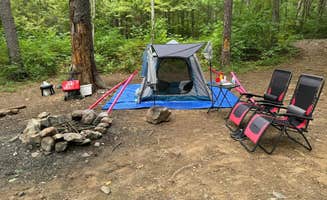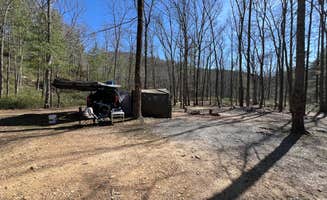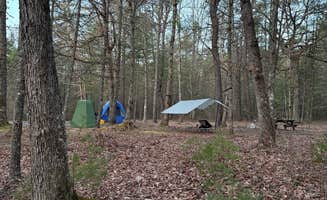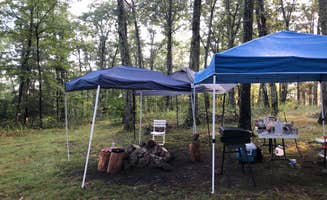Dispersed camping in the George Washington National Forest offers rustic, remote experiences near Blue Ridge, Virginia. The forest encompasses both secluded primitive sites and hike-in options across varying elevations from 1,000 to 4,000 feet. Weather patterns create distinct seasonal opportunities, with spring wildflowers transforming into vibrant fall foliage along the forest's numerous waterways.
What to do
Mountain hiking opportunities: The Spy Rock area connects to several backcountry trails with primitive camping possibilities. "This awesome hike about an hour away from Charlottesville, Va. It is a great hike with a small rock scramble at the top for an extra bit of fun. Not only that, but the top has almost 360 degree views of the Shenandoah Valley," explains Sam M. about Spy Rock.
Rock scrambling and bouldering: For camping hikers seeking additional adventure, many of the high-elevation areas offer climbing opportunities. As one Johns Spring visitor notes, "Another cool thing about this area is that there's some fairly nice bouldering to be found near the top. Some of the routes are a little under maintained and mossy, but there are some fun ones," from a review of Johns Spring Shelter.
Appalachian Trail access: Multiple camping areas connect directly to sections of the AT. One camper at the George Washington National Forest found "There's access to the App Trail on the road so you might see some hikers but it was real quiet otherwise. Pretty nice scenery (you're smack in the middle of the forest) so if you want to get out and away from people this is a great site."
What campers like
Privacy and seclusion: The dispersed areas provide exceptional solitude during weekdays. A visitor to George Washington National Forest reported "Unexpectedly found this site after planning on doing some primitive camping off the road. There's 2 sites that I saw on the road with pits... if you want to get out and away from people this is a great site."
Creek-side camping: Many primitive sites feature direct water access. One camper at George Washington National Forest off 812 shared, "We came for this site specifically but it was already occupied so we kept going down the road. Luckily there were 4-5 additional site & we got one for 3 nights. They are all lovely & creekside with fire pits."
Wilderness cooking options: Several sites feature established stone cooking areas beyond basic fire rings. A camper noted, "There was a fire ring and man made stone oven at the site we chose," providing additional meal preparation options beyond standard campfire cooking.
What you should know
Water filtration essential: Though many sites sit near water sources, treatment remains necessary. At the Dispersed Camping Site off FR 812, one visitor explained, "It is a very rocky path, about 50 feet long, to get into the campground, but then it is smooth and well laid out. There is a giant fire circle in the middle and enough room to fit about 10 vehicles/groups if people don't mind being next to each other."
No cellular connectivity: Most primitive sites in the area lose cellular service within miles of the main roads. A camper confirmed, "No cell service(T-Mobile), but if I drove towards the main road, Route 501, I could get some service."
Road conditions vary significantly: Access to many sites requires navigating unpaved roads of varying quality. One review of Reservoir Road warns, "Went in August and it was very buggy, also had someone park pretty close which when I drive down a really long dirt road that is questionable for my van, i want it to be private and this was about 5 miles of dirt road to get to it."
Tips for camping with families
Site selection timing: For family groups requiring multiple tent spaces, early arrival proves crucial. One camper noted, "Very long road to get there... also had someone park pretty close" at Reservoir Road Dispersed Campsite, highlighting the challenge of finding adequate space during busy periods.
Waste management preparation: No toilet facilities exist at these sites, requiring proper waste disposal practices. One family experienced this challenge firsthand: "My only complaint - that whoever used it last decided to walk a few yards down the trail and use the bathroom right in the middle of the path, leaving their mess and a pile of used wipes on the ground. Gross."
Water access planning: Many but not all sites offer water access for filtering. One visitor to Johns Spring Shelter explained, "I stayed at this AT shelter when I was doing a section hike with some friends... There is not a water source too close to the shelter. The closest one is about 3 miles North."
Tips from RVers
Vehicle clearance requirements: For those with camper vans or small RVs, site accessibility varies significantly. One van camper at George Washington National Forest off 812 reported, "Multiple road sites that fit my van with room to spare - 80% were full on a beautiful fall Friday evening around 6pm but still snagged one."
Group camping configurations: Certain dispersed areas accommodate multiple vehicles with central communal spaces. A visitor explained, "Large open space with several flat areas for tents. There are several spots on this road, maybe 6 but this is the furthest off the road. There are hiking trails and easy access to the stream."
Road navigation challenges: Many dispersed sites require driving on rough forest roads. Drivers must assess whether their vehicles can handle these conditions, as one RVer noted, "It is a hilly drive down back roads off of 81. You loose cell service a couple miles from the site. The site itself is nice, perfect for car camping."






